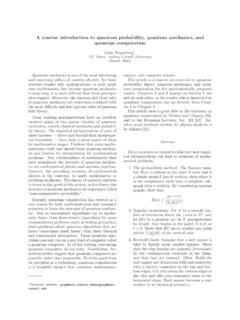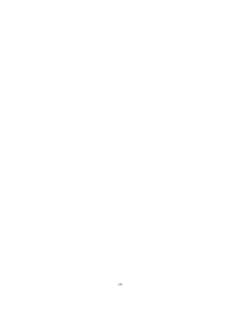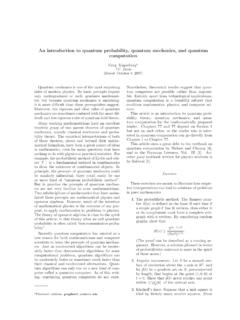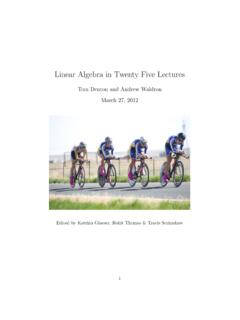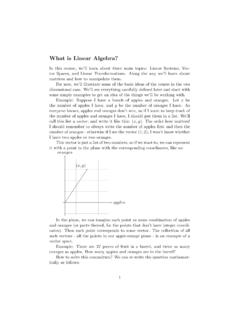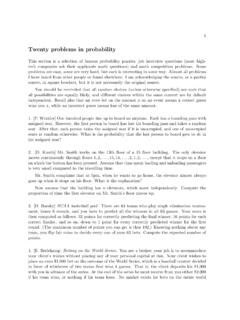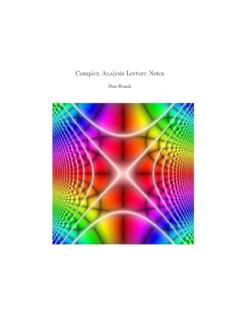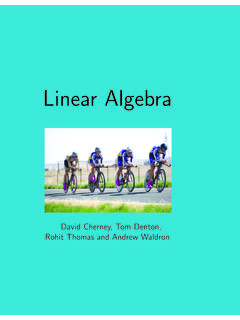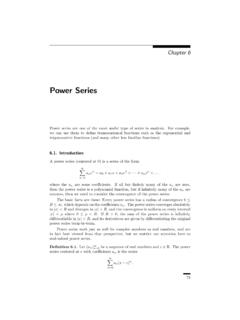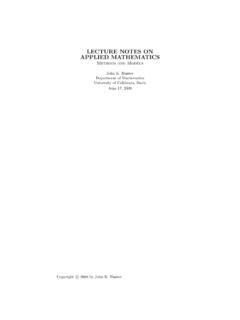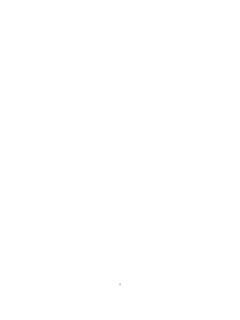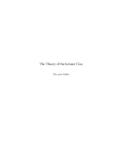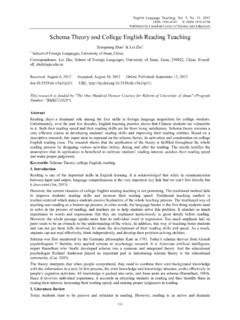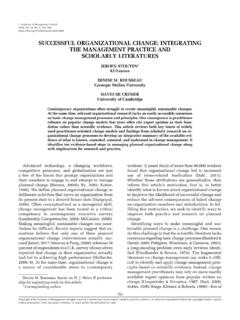Transcription of Measure Notes - University of California, Davis
1 32 CHAPTER 3 measurable functionsMeasurable functions in Measure theory are analogous to continuous functionsin topology. A continuous function pulls back open sets to open sets, while ameasurable function pulls back measurable sets to measurable MeasurabilityMost of the theory of measurable functions and integration does not dependon the specific features of the Measure space on which the functions are defined, sowe consider general spaces, although one should keep in mind the case of functionsdefined onRorRnequipped with Lebesgue (X,A) and (Y,B) be measurable spaces.
2 A functionf:X Yis measurable iff 1(B) Afor everyB that the measurability of a function depends only on the -algebras; it isnot necessary that any measures are order to show that a function is measurable , it is sufficient to check themeasurability of the inverse images of sets that generate the -algebra on the that(X,A)and(Y,B)are measurable spaces andB= (G)is generated by a familyG P(Y). Thenf:X Yis measurable if andonly iff 1(G) Afor everyG operations are natural under pull-backs, meaning thatf 1(Y\B) =X\f 1(B)andf 1( i=1Bi)= i=1f 1(Bi), f 1( i=1Bi)= i=1f 1(Bi).
3 It follows thatM={B Y:f 1(B) A}is a -algebra onY. By assumption,M Gand thereforeM (G) =B, whichimplies thatfis measurable . It is worth noting the indirect nature of the proof of containment of -algebrasin the previous proposition; this is required because we typically cannot use anexplicit representation of sets in a -algebra. For example, the proof does notcharacterizeM, which may be strictly larger the target spaceYis a topological space, then we always equip it with theBorel -algebraB(Y) generated by the open sets (unless stated explicitly otherwise).
4 33343. measurable FUNCTIONSIn that case, it follows from Proposition thatf:X Yis measurable if andonly iff 1(G) Ais a measurable subset ofXfor every setGthat is open inY. Inparticular, every continuous function between topological spaces that are equippedwith their Borel -algebras is measurable . The class of measurable function is,however, typically much larger than the class of continuous functions , since we onlyrequire that the inverse image of an open set is Borel; it need not be Real-valued functionsWe specialize to the case of real-valued functionsf:X Ror extended real-valued functionsf:X will consider one case or the other as convenient, and comment on any differ-ences.
5 A positive extended real-valued function is a functionf:X [0, ].Note that we allow a positive function to take the value equipRandRwith their Borel -algebrasB(R) andB(R). A Borel subsetofRhas one of the formsB, B { }, B { }, B { , }whereBis a Borel subset ofR. As Example shows, sets that are Lebesguemeasurable but not Borel measurable need not be well-behaved under the inverseof even a monotone function, which helps explain why we do not include them inthe range -algebra contrast, when the domain of a function is a Measure space it is oftenconvenient to use a complete space.
6 For example, if the domain isRnwe typicallyequip it with the Lebesgue -algebra, although if completeness is not requiredwe may use the Borel -algebra. With this understanding, we get the followingdefinitions. We state them for real-valued functions ; the definitions for extendedreal-valued functions are completely analogousDefinition (X,A) is a measurable space, thenf:X Ris measurableiff 1(B) Afor every Borel setB B(R). A functionf:Rn Ris Lebesguemeasurable iff 1(B) is a Lebesgue measurable subset ofRnfor every Borel subsetBofR, and it is Borel measurable iff 1(B) is a Borel measurable subset ofRnfor every Borel subsetBofRThis definition ensures that continuous functionsf:Rn Rare Borel measur-able and functions that are equal to Borel measurable functions are Lebesguemeasurable.
7 Iff:R Ris Borel measurable andg:Rn Ris Lebesgue (orBorel) measurable , then the compositionf gis Lebesgue (or Borel) measurablesince(f g) 1(B) =g 1(f 1(B)).Note that iffis Lebesgue measurable , thenf gneed not be measurable sincef 1(B) need not be Borel even ifBis can give more easily verifiable conditions for measurability in terms ofgenerating families for Borel REAL-VALUED FUNCTIONS35 Proposition Borel -algebra onRis generated by any of the followingcollections of intervals{( ,b) :b R},{( ,b] :b R},{(a, ) :a R},{[a, ) :a R}.
8 -algebra generated by intervals of the form ( ,b) is containedin the Borel -algebraB(R) since the intervals are open sets. Conversely, the -algebra contains complementary closed intervals of the form [a, ), half-openintersections [a,b), and countable intersections[a,b] = n=1[a,b+1n).From Proposition , the Borel -algebraB(R) is generated by the collection ofclosed rectangles [a,b], so ({( ,b) :b R}) =B(R).The proof for the other collections is similar. The properties given in the following proposition are sometimes taken as thedefinition of a measurable (X,A)is a measurable space, thenf:X Ris measurableif and only if one of the following conditions holds:{x X:f(x)< b} Afor everyb R;{x X:f(x) b} Afor everyb R;{x X:f(x)> a} Afor everya R;{x X:f(x) a} Afor everya that, for example,{x X:f(x)< b}=f 1(( ,b))and the result follows immediately from Propositions and If any one of these equivalent conditions holds, thenf 1(B) Afor every setB B(R).]]]
9 We will often use a shorthand notation for sets, such as{f < b}={x X:f(x)< b}.The Borel -algebra onRis generated by intervals of the form [ ,b), [ ,b],(a, ], or [a, ] wherea,b R, and exactly the same conditions as the onesin Proposition imply the measurability of an extended real-valued functionsf:X R. In that case, we can allowa,b Rto be extended real numbersin Proposition , but it is not necessary to do so in order to imply is well-behaved with respect to algebraic ,g:X Rare real-valued measurable functions andk R,thenkf,f+g, fg, f/gare measurable functions , where we assume thatg6= 0in the case measurable >0, then{kf < b}={f < b/k}sokfis measurable , and similarly ifk <0 ork= 0.
10 We have{f+g < b}= q+r<b;q,r Q{f < q} {g < r}sof+gis measurable . The functionf2is measurable since ifb 0{f2< b}={ b < f < b}.It follows thatfg=12[(f+g)2 f2 g2]is measurable . Finally, ifg6= 0{1/g < b}= {1/b < g <0}ifb <0,{ < g <0}ifb= 0,{ < g <0} {1/b < g < }ifb >0,so 1/gis measurable and thereforef/gis measurable . An analogous result applies to extended real-valued functions provided thatthey are well-defined. For example,f+gis measurable provided thatf(x),g(x)are not simultaneously equal to and , andfgis is measurable provided thatf(x),g(x) are not simultaneously equal to 0 and.
